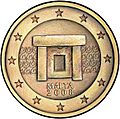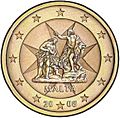Maltese euro coins facts for kids
Maltese euro coins are the special coins made by Malta for the euro. Each euro coin has a "common side" that looks the same across all countries, and a "national side" that shows designs chosen by each country. Malta has three different designs for its euro coins.
Malta joined the European Union on May 1, 2004. It then became part of the group of countries that use the euro. On January 1, 2008, Malta officially started using the euro as its money, replacing its old currency, the Maltese lira. For one month, until January 31, 2008, people in Malta could use both euros and Maltese liras.
Contents
Maltese Euro Coin Designs
The euro coins from Malta show three different designs. These designs are found on the "national side" of the coins. You can see what the common side of all euro coins looks like by visiting the euro coins page.
| €0.01 | €0.02 | €0.05 |
|---|---|---|
| The Mnajdra temple altar | ||
| €0.10 | €0.20 | €0.50 |
 |
||
| The Coat of arms of Malta | ||
| €1.00 | €2.00 | €2 Coin Edge |
| The Maltese cross | ||
- The 1, 2, and 5 cent coins show the altar from the ancient Mnajdra temple. This temple is a very old and important historical site in Malta.
- The 10, 20, and 50 cent coins feature the Coat of arms of Malta. This is the official symbol of the country.
- The €1 and €2 coins display the Maltese cross. This cross is a famous symbol linked to Malta's history, especially with the Knights of St. John.
How the Designs Were Chosen
Malta decided on its euro coin designs by asking the public for their ideas. This process happened in two main steps.
First Round of Voting
The first step started on January 14, 2006, and ended on January 29, 2006. During this time, people in Malta could choose from twelve different design ideas. These ideas were grouped into four themes:
- Prehistoric Malta
- Renaissance Malta
- The Maltese Identity
- The Maltese Archipelago
For each theme, there were three different options to pick from.
The most popular choices from this first vote were:
- The Baptism of Christ in St John’s Co-Cathedral (3,498 votes)
- Malta’s Coat of arms of Malta (2,742 votes)
- The Mnajdra Temple Altar (1,872 votes)
Another design, Fort St. Angelo, also got many votes (2,037). However, it wasn't chosen because the "Baptism of Christ" design received more votes in its theme.
Besides these visual designs, people also suggested their own ideas. The two most popular suggestions from the public were the Maltese cross and Dun Karm (a famous Maltese poet). The committee in charge of adopting the euro decided to include the most popular public suggestion, the Maltese Cross, along with the three designs chosen by the public.
These four final ideas were then given to a designer named Noel Galea Bason. He created detailed pictures of how each design would look on a coin for the next round of voting.
Second Round of Voting
The second step took place from May 29 to June 9, 2006. The public was asked to choose the actual designs for the euro coins from the four detailed pictures made by the designer. The three designs with the most votes would become the final look for Malta's euro coins.
The results of this second vote were:
- The Maltese cross
- The Coat of arms of Malta
- The Mnajdra Temples
The Central Bank of Malta officially showed these final designs on February 19, 2007. Later, on October 23, 2007, the designs were officially published in the Official Journal of the European Union.
How Many Coins Were Made (Mintage Quantities)
"Mintage quantity" means how many coins of each type were made in a certain year. Here's a table showing how many Maltese euro coins were minted in some early years:
| Coin Value | €0.01 | €0.02 | €0.05 | €0.10 | €0.20 | €0.50 | €1.00 | €2.00 |
|---|---|---|---|---|---|---|---|---|
| 2008 | 10,000,000 | 36,000,000 | 34,000,000 | 41,000,000 | 40,000,000 | 15,000,000 | 14,000,000 | 10,000,000 |
| 2009 | * | * | * | * | * | * | * | * |
| 2010 | * | * | * | * | * | * | * | 2,000,000 |
| 2011 | 50,000 | 50,000 | 50,000 | 50,000 | 50,000 | 50,000 | 50,000 | 50,000 |
| 2012 | 50,000 | 50,000 | 50,000 | 50,000 | 50,000 | 50,000 | 50,000 | 50,000 |
|
* No coins were made that year for that value. |
||||||||
Where the Coins Were Made (Mints)
- From 2008, and again from 2016 to 2018, Maltese euro coins were made in France.
- From 2010 to 2015, they were made in the Netherlands.
Special Marks on Coins
Euro coins have special marks that help identify where they came from and who designed them.
| Country Mark | "MALTA" |
| Mint Mark | F (This letter "F" is only on coins made in France.) |
| Designer's Initials | For the 1, 2, and 5 cent coins, you can find the initials NGB. |
| €2 Edge Design |
Special €2 Commemorative Coins
Besides the regular coins, Malta also makes special €2 coins called "commemorative coins." These coins are made to celebrate important events or topics.
Maltese History Coins
Malta has a series of €2 commemorative coins that tell the story of its constitutional history.
| Year | Coin Number | Design |
|---|---|---|
| 2011 | 1 | First Election of Representatives in 1849 |
| 2012 | 2 | Majority Representation in 1887 |
| 2013 | 3 | Establishment of Self-Government in 1921 |
| 2014 | 4 | Independence from Britain in 1964 |
| 2015 | 5 | Proclamation of the Republic of Malta in 1974 |
Children in Solidarity Coins
This series of coins highlights the role of the Malta Community Chest Fund, which helps people in society.
| Year | Coin Number | Design |
|---|---|---|
| 2016 | 1 | Solidarity through love |
| 2017 | 2 | Solidarity and peace |
| 2018 | 3 | Cultural heritage |
| 2019 | 4 | Nature/Environment |
| 2020 | 5 | Children's game |
Maltese Ancient Sites Coins
This series features famous prehistoric sites in Malta.
| Year | Coin Number | Design |
|---|---|---|
| 2016 | 1 | Ġgantija |
| 2017 | 2 | Ħaġar Qim |
| 2018 | 3 | Mnajdra |
| 2019 | 4 | Ta' Ħaġrat Temples |
| 2020 | 5 | Skorba Temples |
| 2021 | 6 | Tarxien Temples |
| 2022 | 7 | Hypogeum of Ħal-Saflieni |
Other Collector Coins
Since joining the Eurozone in 2008, Malta has also made special collector coins out of silver and gold. These coins have values like 10 or 50 euro. They are made mostly for collectors and are not meant to be used for everyday shopping.
See also
- Malta in the European Union






